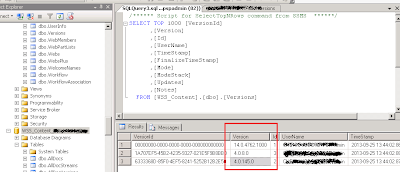Difference between sequential workflow and state machine workflow
Sequential Workflow:
A sequential workflow is a predictable workflow. The execution path might branch, or loop, or wait for an outside event to occur, but in the end, the sequential workflow will use the activities, conditions, and rules we've provided to march inevitably forward. The workflow is in control of the process.
We use a sequential workflow when we can encode most of the decision-making inside the workflow itself.
State Machine Workflow:
A state-machine workflow is an event driven workflow. That is, the state machine workflow relies on external events to drive the workflow to completion. We define the legal states of the workflow, and the legal transitions between those states. The workflow is always in one of the states, and has to wait for an event to arrive before transitioning to a new state. Generally, the important decisions happen outside of the workflow. The state machine defines a structure to follow, but control belongs to the outside world.
We use a state machine workflow when the decision-making happens outside the workflow.
As name suggests, a sequential workflow executes in a sequence and there is no condition while state machine will have conditions and based on the condition, flow will go to the matching direction. If you installed WF, it comes with a documentation that clearly explains the difference.
Source :http://pravahaminfo.blogspot.in/2010/11/difference-bw-sequential-workflow-and.html
A sequential workflow is a predictable workflow. The execution path might branch, or loop, or wait for an outside event to occur, but in the end, the sequential workflow will use the activities, conditions, and rules we've provided to march inevitably forward. The workflow is in control of the process.
We use a sequential workflow when we can encode most of the decision-making inside the workflow itself.
State Machine Workflow:
A state-machine workflow is an event driven workflow. That is, the state machine workflow relies on external events to drive the workflow to completion. We define the legal states of the workflow, and the legal transitions between those states. The workflow is always in one of the states, and has to wait for an event to arrive before transitioning to a new state. Generally, the important decisions happen outside of the workflow. The state machine defines a structure to follow, but control belongs to the outside world.
We use a state machine workflow when the decision-making happens outside the workflow.
As name suggests, a sequential workflow executes in a sequence and there is no condition while state machine will have conditions and based on the condition, flow will go to the matching direction. If you installed WF, it comes with a documentation that clearly explains the difference.
Source :http://pravahaminfo.blogspot.in/2010/11/difference-bw-sequential-workflow-and.html

Comments
Post a Comment